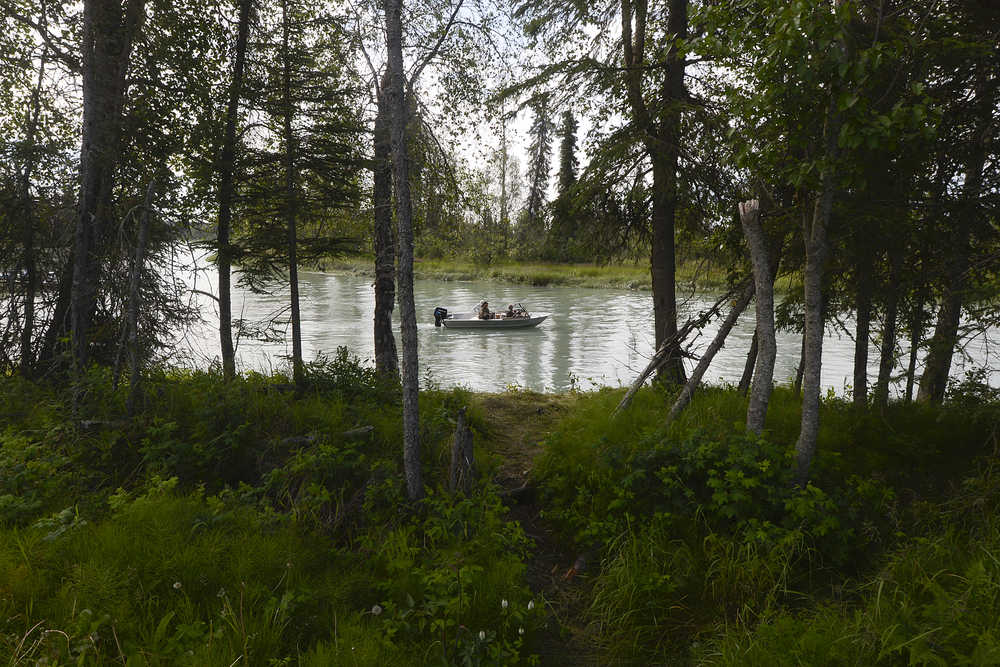Twice a day, at least during the fishing season, Tracy Poore leaves his house, walks to he end of his driveway and then down the long, deeply sloped road to the Eagle Rock Boat Launch.
It’s a deeply ingrained habit, the Poore’s have owned the boat launch site since the 50s, and he can keep an eye on things now that the Alaska Department of Natural Resources operates the boat launch and parking area.
The site is now owned by the state, purchased through money from the Exxon Valdez Oil Spill Trustee Council, and operated by the state’s division of parks.
The council, or EVOS, has purchased at least 5,100 acres on the Kenai River, at a cost of more than $12.3 million, primarily to enable habitat restoration and provide more recreational and sport fishing access, according to its website.
On a recent Friday, the boat launch was busy, though Poore said he’s seen much larger crowds.
More than 50 trucks and boat trailers parked in two adjacent gravel lots near the boat launch — while dozens more parked along the access road and then along a utility road near the Kenai Spur Highway.
Trailers backed down the launch, usually in pairs, and boats shoved-off into the calm waters of the slough before anchoring near shore and waiting for passengers.
Still, the 20 or so boats in the vicinity didn’t surprise Poore.
“When it was busy in the 90s — when there were a lot of kings and king season was longer — you could look out at the river and just see, in that short stretch, 100 boats,” he said.
While king salmon fishing on the river has slowed, Poore said the boat launch still sees heavy use, just from a different type of fisher.
“Now it’s all dipnetters,” he said, referring to the personal-use fishers who descend on the Kenai River each year for a chance at the late run of sockeye salmon.
“(This crowd) will go away so much quicker,” he said of the dipnetters. “Once they get their fish, they’re done.”
The state has made few substantive changes in operation during its first season in operation, said Alaska State Parks Area Superintendent Jack Blackwell.
“Probably the one thing that folks notice this year, is that camping is no longer allowed at the site,” he said. “We wanted to try to maximize the amount of parking that’s available for boaters and there’s other private and public sites along the river that are available for camping — but few public boat launches.”
One upgrade scheduled for 2014 is the replacement of the site toilets.
Blackwell said state parks had received about $1 million from the legislature and would be putting three new toilets on the river, one at Eagle Rock, a new one on the Lower Kenai River and one on the Middle River upstream of Bing’s Landing.
That money will also be used in the planning for boat launch upgrades at Eagle Rock, though Blackwell said those plans had yet to be solidified.
Blackwell said a site plan was being developed between the state and the Kenai River Special Management Area board.
Planned upgrades to the Eagle Rock boat launch site include new signs and landscaping, a camping site for a volunteer host, and an electronic fee station, according to the capital funding request to the legislature.
Many waiting to use the launch said they’d like to see some improvements and more areas for parking.
Robert Flygenring, an Anchorage resident with a cabin in Ninilchik, didn’t have much to say about the change in management but said he preferred to use the Eagle Rock Boat Launch because it is the closest to the area where personal use fishing is allowed on the Kenai River.
“It’s close to the mouth,” he said. “When you launch at the (Kenai) City Docks, the tide messes you up. Up here, you can get in and out every time.”
Blackwell said members of the public who wanted to weigh in on the boat launch could do so at special management area, or KRSMA, board meetings.
“We’ll have an open process that will be coordinated through the KRSMA board. The KRSMA board is our primary method for incorporating public involvement through the management of the Kenai River,” he said.
One other change that users may notice in 2014 is the $15 launch fee and $5 parking fee charged by the state.
Several dipnetters readying their boats for launch said that previous launch operators had sometimes changed fees depending on how busy the site was and how many people wanted to use it.
Poore sat on his deck overlooking the water and said he was glad to see the state take over operations, especially if improvements were on the way.
“It’s actually sort of a relief, due to all of the liability,” he said. “I’ve wanted it improved for years. They took all of the worry out.”
State managers coordinated with the City of Kenai to get signs prohibiting parking placed along the road entering the boat launch, pacifying some in the neighborhood who were overwhelmed by the traffic.
Poore said things were looking up in the area.
“It’ll probably be better for the neighbors who won’t have a grumpy old guy like me running it,” he said, grinning.
Rashah McChesney can be reached at rashah.mcchesney@peninsulaclarion.com

